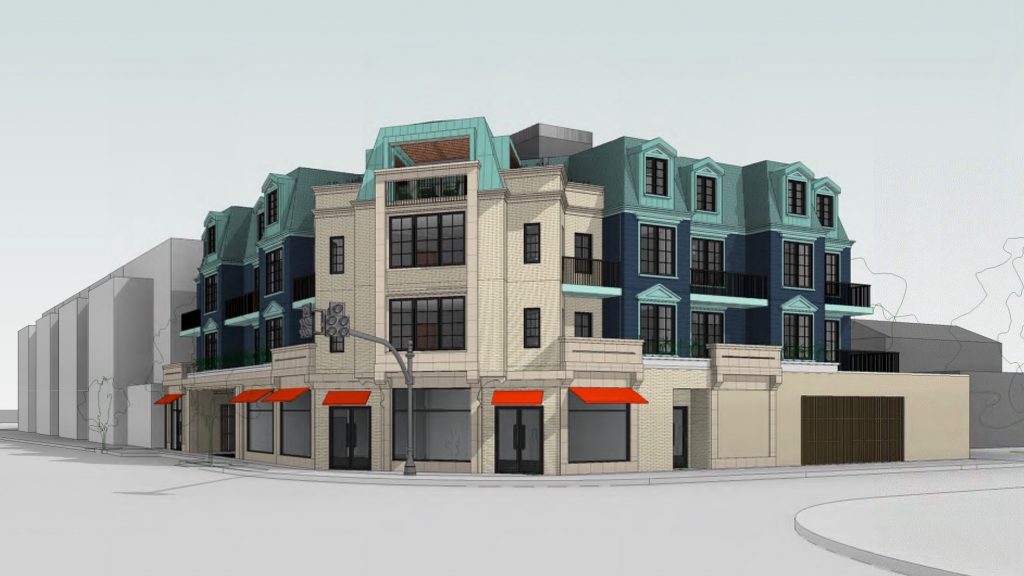
Reading, MA — By a vote of 1-3, the Community Planning and Development Commission (CPDC) denied the requested density waiver of fifty-one units per acre for the proposed 40R mixed-use development project at 459 Main Street on Monday. The project is proposed as a four-story building with twelve residential units and one commercial space at the site of the current 128 Tire and abuts the Rise 475 building on Main Street.
CPDC members and abutters had raised concerns since the beginning of the public hearing, which opened on February 7, about traffic and other impacts on the intersection of Washington Street and Main Street that the project could create. CPDC member John Weston, who had missed two meetings on the project and was unable to vote, noted that concerns regarding building residents exiting the garage of the proposed building on to Washington Street had been met only with a commitment to posting a sign that says “No left turn,” yet offers no practical way to prevent people from ignoring the sign and turning whichever way they please.
“[There are] a lot of little nuances here that create a problem,” Weston continued. “[This building] just doesn’t work.”
In response, Attorney Jesse Schomer, speaking for the applicant G.C. Fodera Contracting, suggested, “The proposed project is one of the least impactful uses of land that can be developed in a business district or a smart growth district . . . the current use of the property . . . has far more impact [on the intersection].”
When asked by Schomer what density would be acceptable to the board, CPDC member Tony D’Arezzo indicated his reason for voting against the waiver. “The density proposed has consequences including an unacceptable shadow overrunning an abutting residence.” D’Arezzo also reminded the commission that this project is the only 40R they have voted on, which never offered to reduce density at any point in the process. He continued that he could not provide Schomer a number without seeing how a lower density would impact the rest of the project. CPDC chair Heather Clish indicated that the location of the project was what motivated her ‘no’ vote. “Everything that happens there impacts a challenging intersection,” Clish noted.
Town Counsel Ivria Fried provided three options for the board to move forward after the waiver request denial. The first was to simply deny the project outright, the second was to approve the project without the waiver, and the third was that the CPDC could approve a by-right project with a density of twenty units per acre, which calculates to a project with 4.7 residential units.
Recognizing that 4.7 units in a building is unachievable, CPDC voted 3-1 to approve a density condition for 21.24 units per acre, which would allow for five units in the building. Also, recognizing that waiver requests for parking dimensions, garage aisle width, landscaping design, and design guideline considerations had been approved by the commission, CPDC chose option two and voted 3-1 to approve the project at the lower density.
Schomer indicated that he would have to consult with his clients regarding next steps, which he suggested could include litigation on the matter.
Oakland Road
CPDC began the meeting with a concept plan review for a proposed affordable and senior housing project on the town-owned land across Oakland Road from Reading Memorial High School. Town Manager Fidel Maltez introduced the project, stating, “Seniors are getting priced out of Reading.” He also reminded the CPDC that there are “many hurdles” in getting the project done and that “It is not a done deal.”
CPDC-Meeting-Town-Manager-PresentationArchitect Jennifer Hocherman from SV Design revealed the plan, similar to the one presented to the community in a July forum. The suggested plan is for the site to be divided into two sections; the northern portion of the property would be developed with a three-story senior housing facility built into the hill encompassing thirty-five units. On the site’s southern section, six duplexes would be built on a cul-de-sac with a small clubhouse and a landscaped play area in the middle. Hocherman indicated that one change from the previous plan is the elimination of garages from the duplexes as well as the addition of two walking paths that would connect the abutting neighborhoods with Oakland Road.
OaklandRd_RevisedSchematics_9-12-22Much discussion by the CPDC and the public focused on increased traffic impacts on the abutting neighborhoods. “It is the right thing to do, but not in the right area,” Weston declared while noting that the project is proposed in an S-15 residential district. Neighbor Jonathan Webber concurred, “We are thinking the right way, this is the wrong place.”
Residents Mary Ellen O’Neil and Carolyn Whiting expressed environmental concerns as well. “We need to hold on to every tree we have,” O’Neil declared. While Whiting questioned the amount of water runoff from a rocky and sloped site, a concern was also addressed by direct abutter George English. “You can’t stuff all these people in one area, especially when it has been congested by the school system,” English added.
Maltez indicated that looking at the use of this property for affordable housing was part of the 2018 housing production plan filed with the state. The review concluded with Clish stating her personal support for affordable housing “that is well-planned and well thought out.” No timeline was given as to next steps for the proposed project.
CPDC adjourned at 11:45pm.
